PTX10016 System Overview
The Juniper Networks PTX10016 Packet Transport Routers bring innovations in the physical and virtual environments to the service provider core network. These next-generation routers help network operators achieve their business goals. The routers effectively handle current traffic demands and are scalable for future traffic demands.
PTX10016 Packet Transport Router Description
PTX10016 routers provide cloud and data center operators with the highest levels of scale and throughput. PTX10016 is a next-generation modular router that offers ultra-high system capacity in a 21 U platform. It provides 230.4 Tbps per chassis. The PTX10016 has 16 slots for line cards that allow for a smooth transition from 10GbE, 40GbE, and 100GbE networks to 400GbE high-performance networks.
You can manage and monitor PTX10016 router by using the CLI. In addition to the CLI, you can manage and monitor the PTX10016 router by using Juniper Routing Director (formerly Juniper Paragon Automation) or Juniper Paragon Automation.
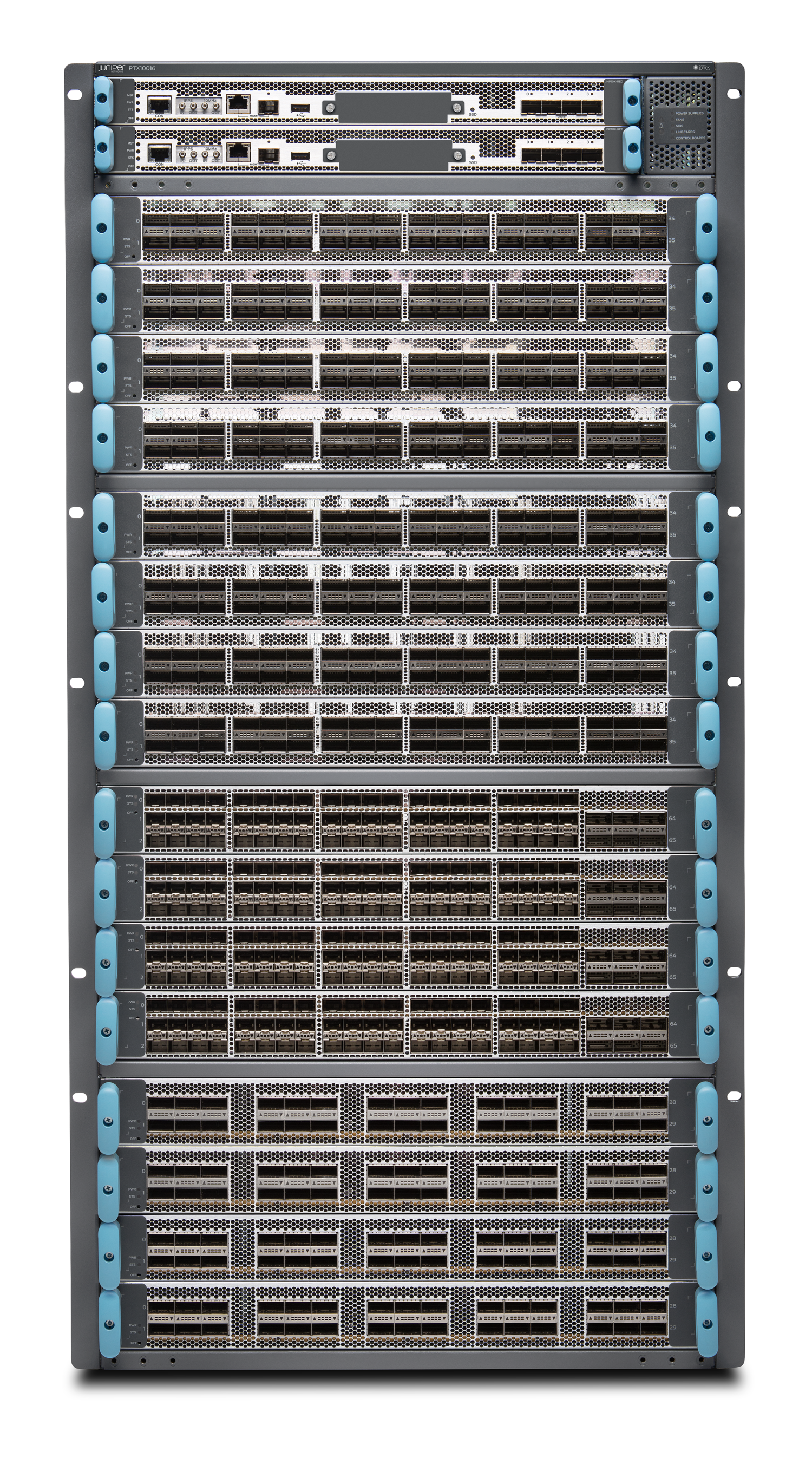
You can deploy the PTX10016 in various network designs and fabrics, including:
-
Label-switched core routing
-
IP core
-
Peering
The PTX10016 routers come with either JNP10016-SF Switch Interface Boards (SIBs) or JNP10016-SF3 SIBs. If your PTX10016 has JNP10016-SF SIBs, it will come preinstalled with Junos® operating system (Junos OS). If your PTX10016 has JNP10016-SF3 SIBs, it will come preinstalled with Junos OS Evolved.
The PTX10016 is available in base and redundant configurations for operation with both AC and DC inputs. All configurations support front-to-back airflow, which is also known as airflow out (AFO).
Here is a brief overview of the PTX10016 router:
- Benefits of the PTX10016 Router
- Chassis Description
- Routing and Control Board
- Line Cards
- Switch Interface Boards
- Cooling System
- Power Supplies
- Software
Benefits of the PTX10016 Router
-
System capacity—The PTX10016 has a 21-RU form factor and provides 230.4 Tbps per chassis.
-
Full-scale IP and MPLS routing—The PTX10016 delivers the distributed peering scale of 2.9 million forwarding information bases (FIBs) and 30 million routing information bases (RIBs) (also known as forwarding tables, and routing tables, respectively), 3000 OSPF adjacencies, and 4000 BGP sessions that are required to match expanding traffic demands.
-
Source Packet Routing in Networking (SPRING)—SPRING on the PTX10016 provides additional flexibility per packet source. SPRING provides network path and node protection to support:
- MPLS fast reroute (FRR) mechanisms.
- Enhanced network programmability.
- Operation, Administration, and Maintenance (OAM) functionality.
- Simplified network signaling, load balancing, and traffic engineering functions.
-
Nondisruptive software upgrades—The Junos OS running on the PTX10016 supports high availability (HA) features such as graceful Routing Engine switchover (GRES) and nonstop active routing (NSR), providing software upgrades and changes without disrupting network traffic.
Chassis Description
The PTX10016 is 21-U tall. Two PTX10016 chassis can fit in a standard 42-U rack with adequate cooling and power. All key PTX10016 components are field-replaceable units (FRUs). Figure 2 illustrates the components visible from the front of the chassis, Figure 3 illustrates the components that are visible from the rear of the chassis, and Figure 4 illustrates the components that are internal to the chassis.
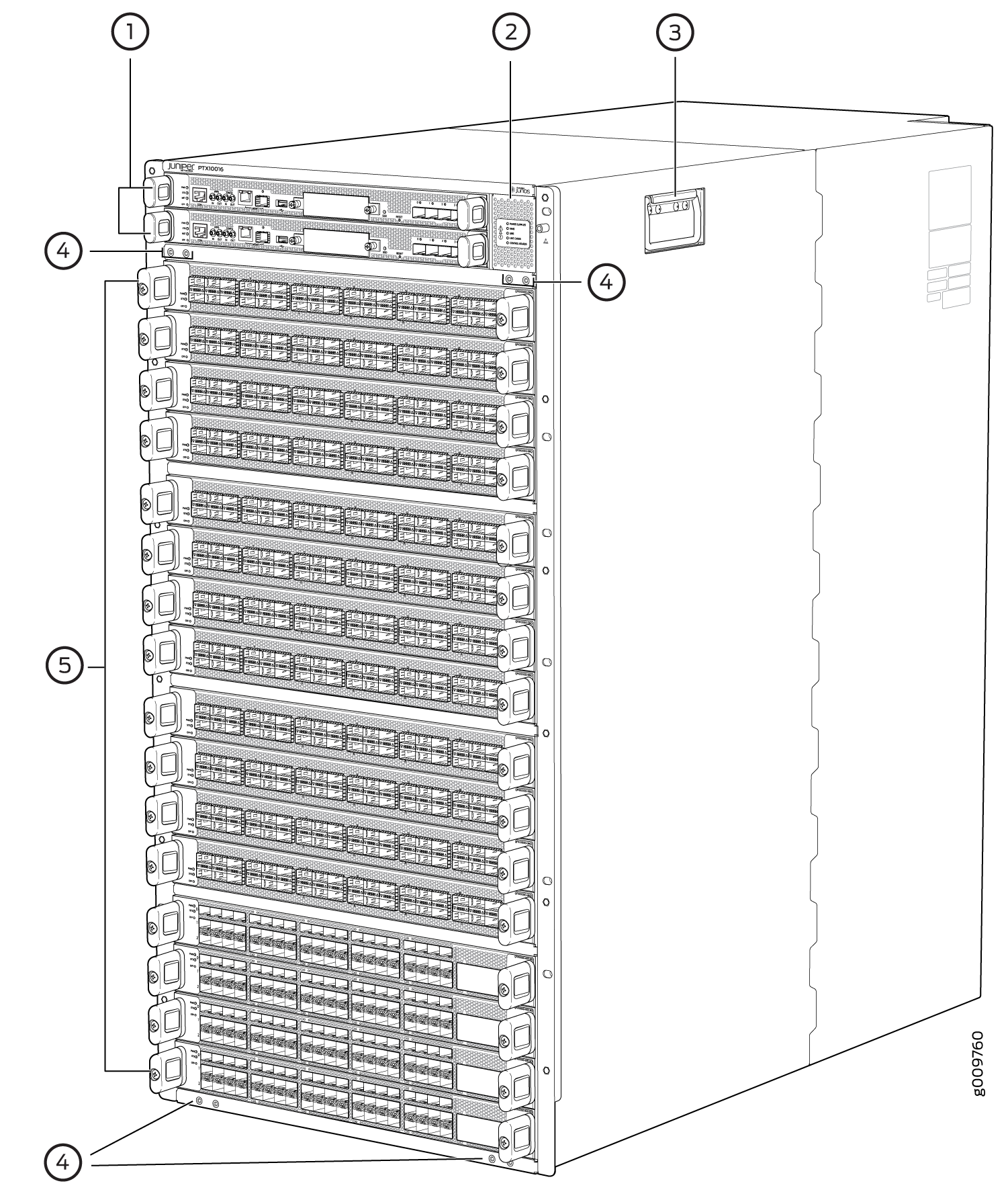
1 — Routing and Control Boards | 4 — Installation holes for the front panel |
2 — Status LED panel | 5 — Line card slots 0-15 (numbered top to bottom) |
3 — Handle |
Some chassis ship with an enhanced power bus to future-proof the chassis beyond the current generation of line cards. You can determine which chassis you have by markings on the status panel (see PTX10016 Status Panel).
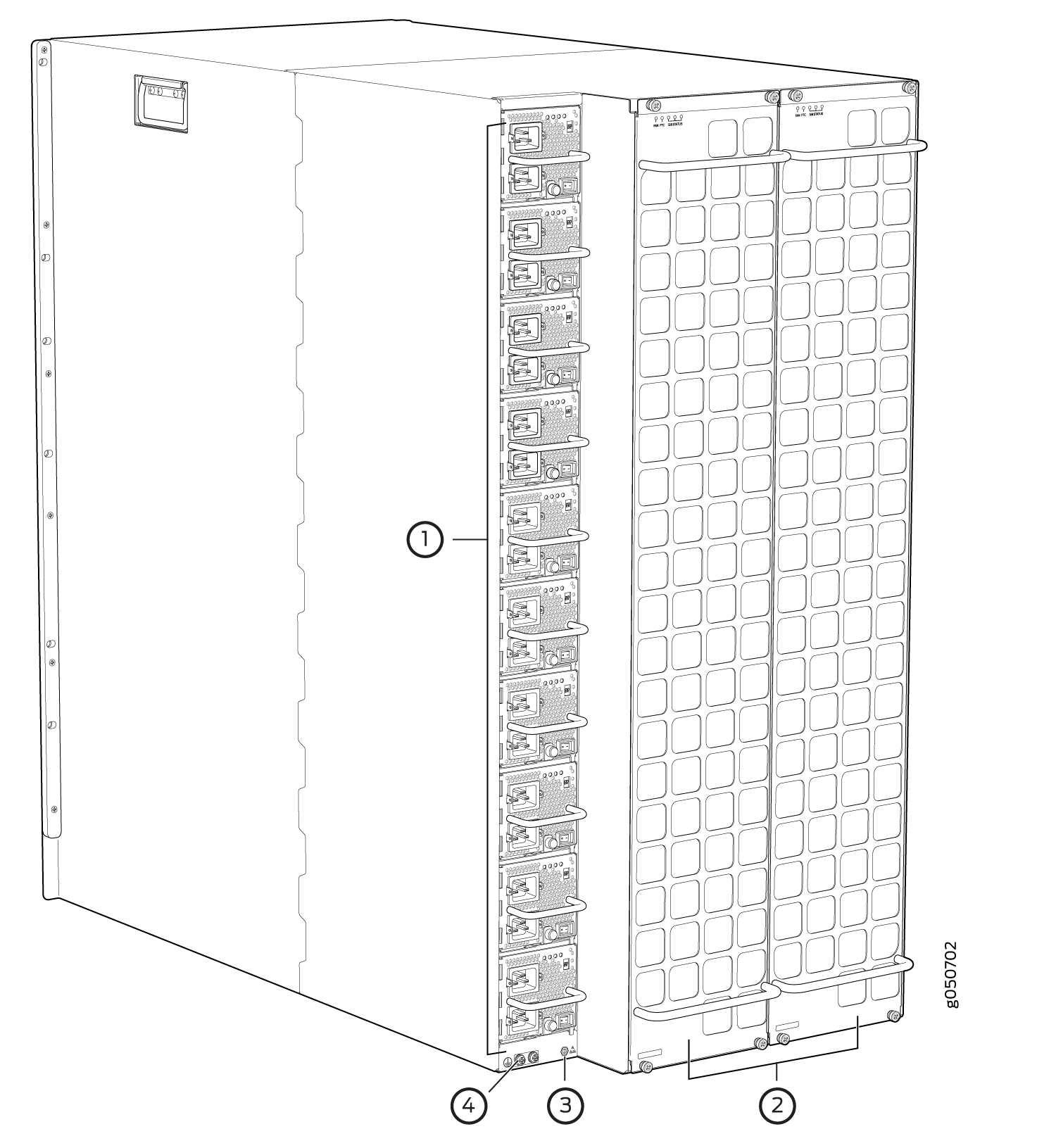
1 — Power supplies | 3 — ESD point |
2 — Fan trays | 4 — Protective earthing terminal |
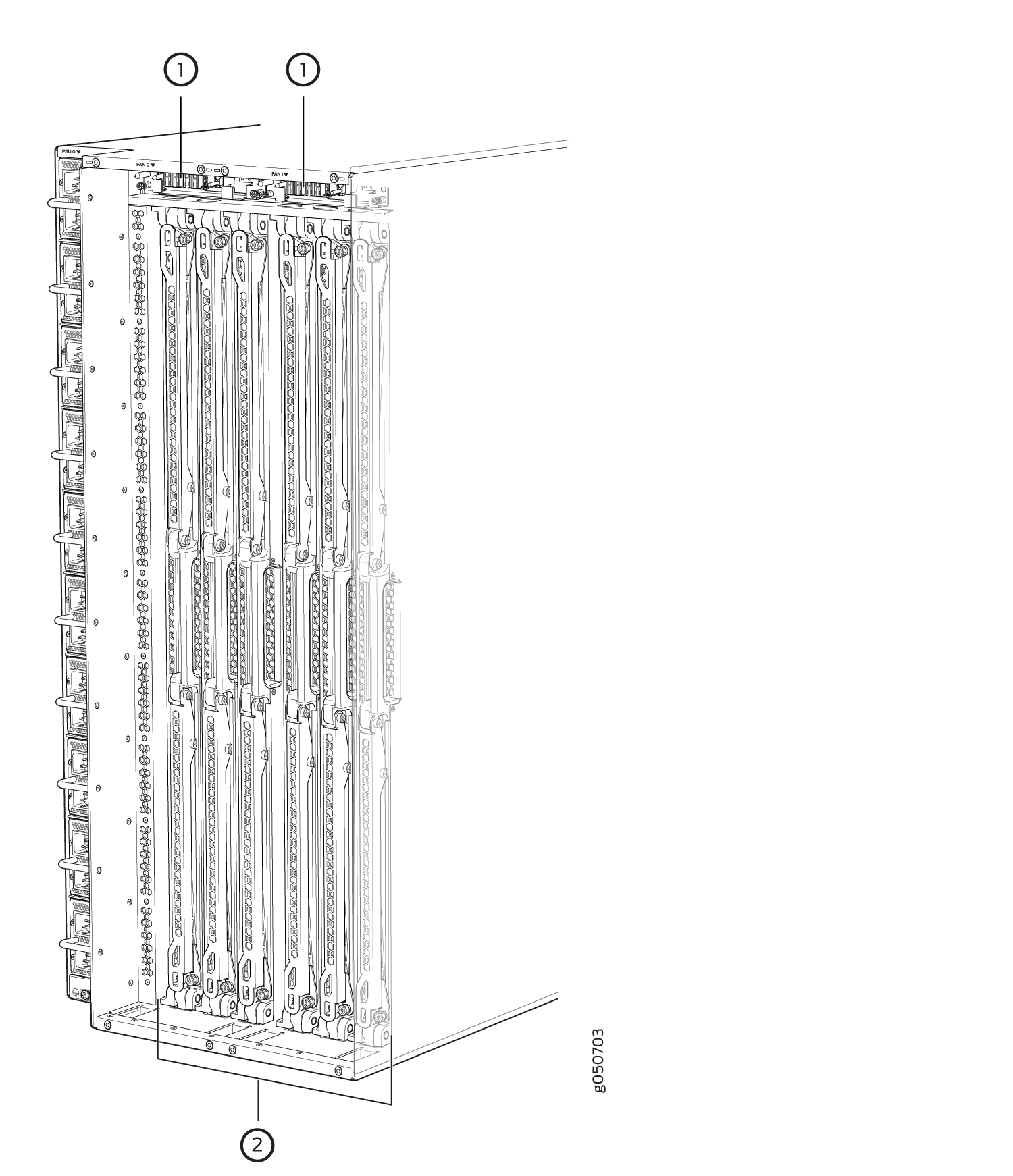
1 — Fan tray controllers | 2 — Switch Interface Boards (SIBs) |
See PTX10016 Chassis Physical Specifications and PTX10016 Field-Replaceable Units.
Routing and Control Board
The RCB contains a Routing Engine and is responsible for the system management and system control in the PTX10016. See PTX10016 Routing and Control Board Description. RCBs are FRUs that are installed in the front of the chassis in the slots labeled CB0 and CB1. The base configurations have a single RCB. The redundant configurations have two RCBs. Each RCB contains Precision Time Protocol (PTP) ports and four Media Access Control Security (MACsec) capable ports. See PTX10016 Components and Configurations.
Line Cards
The PTX10016 features 16 horizontal line card slots. The line cards combine a Packet Forwarding Engine and Ethernet interfaces enclosed in a single assembly. The line cards are FRUs that you can install in the line card slots labeled 0 through 15 (top to bottom) on the front of the router chassis.
Switch Interface Boards
Switch Interface Boards (SIBs) create the switch fabric for the PTX10016 router. The PTX10016 supports two models of SIBs:
- The JNP10016-SF SIB supports Junos OS and has a switching capacity of 14.4 Tbps in one direction.
- The JNP10016-SF3 SIB supports Junos OS Evolved Release 21.2R2 and later, and has a forwarding capacity of 45.9 Tbps in one direction.
You must install the SIBs between the line cards and the fan trays inside the chassis. Each SIB has 16 connectors that match to a line card slot, eliminating the need for a backplane. When six JNP10016-SF SIBs are installed, the PTX10016 has a routing capacity of 96 Tbps. When six JNP10016-SF3 SIBs are installed, the PTX10016 has a routing capacity of 565 Tbps. See PTX10016 Switch Interface Board Description.
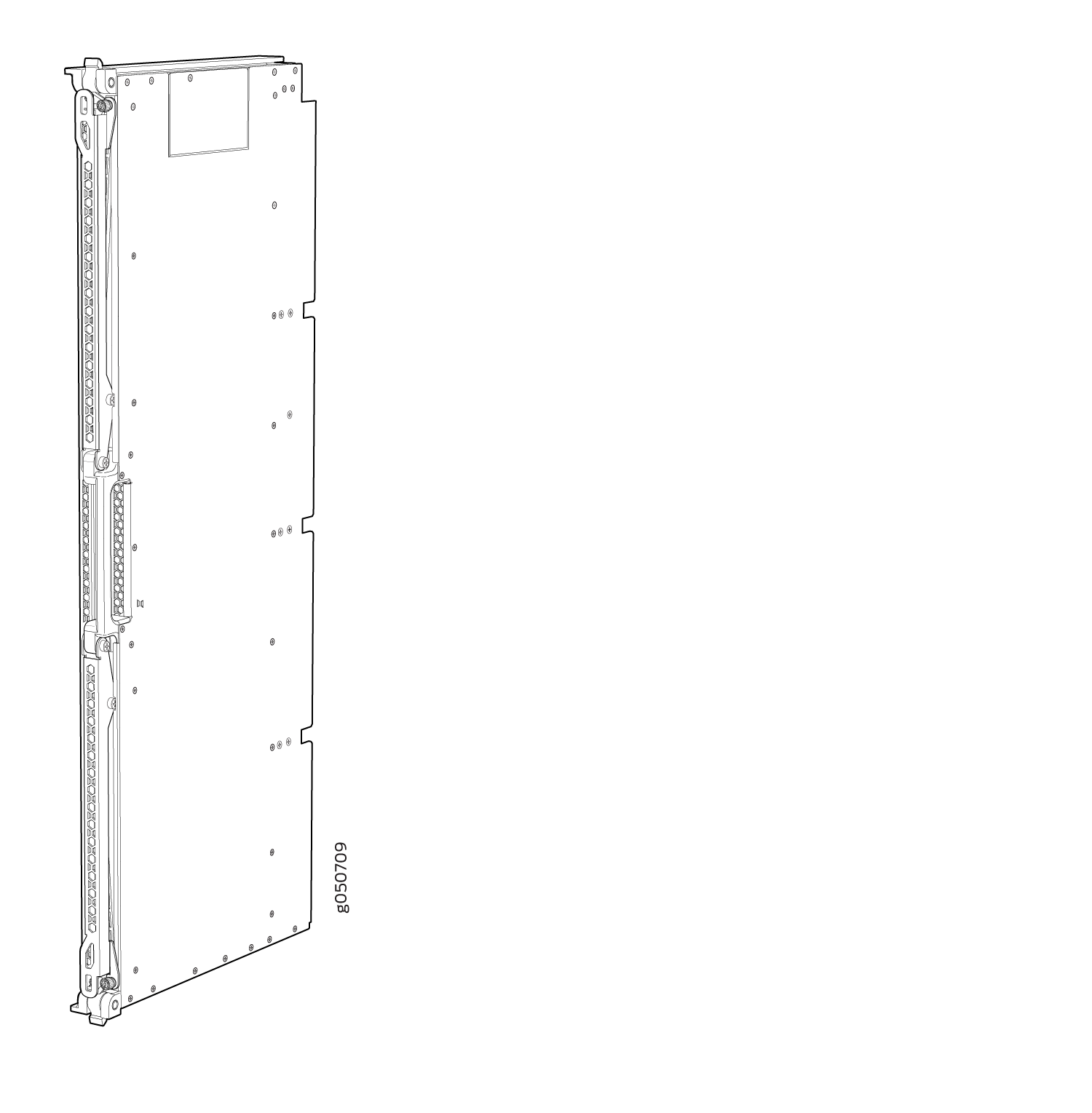
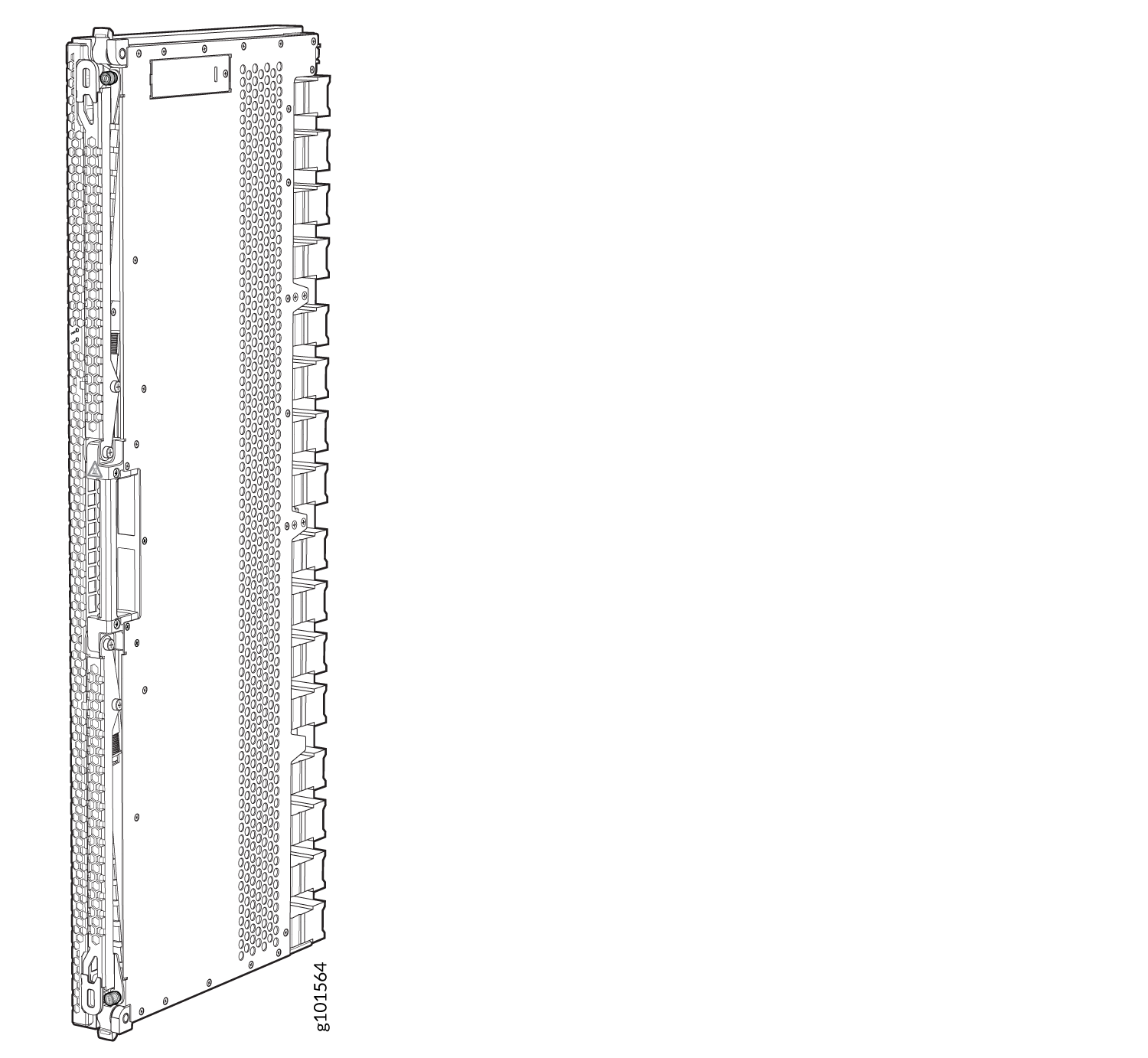
Each SIB model has a set of unique connectors to mate the line cards and the RCB to the switch fabric. Some system components are also designed to operate with a specific switch fabric. See Table 1 for the components that each switch fabric supports.
|
Specification |
JNP10016-SF |
JNP10016-SF3 |
|---|---|---|
|
Operating system |
Junos OS Release 17.4R1 and later |
Junos OS Evolved Release 21.2R2 and later |
|
RCB |
|
|
|
Fan tray and fan tray controller |
JNP10016-FAN with JNP10016-FAN-CTRL or JNP10016-FAN2 with JNP10016-FTC2 |
JNP10016-FAN2 with JNP10016-FTC2 |
|
Power supply |
|
|
|
Supported line cards |
|
|
Cooling System
The cooling system in a PTX10016 consists of two hot-removable and hot-insertable FRU fan trays (see Figure 7 and Figure 8) and two fan tray controllers (see Figure 9 and Figure 10). Each JNP10016-FAN fan tray contains 21 fans and each JNP10016-FAN2 fan tray contains 42 fans. The fan trays install vertically on the rear of the chassis and provide front-to-back chassis cooling. See PTX10016 Cooling System and Airflow.
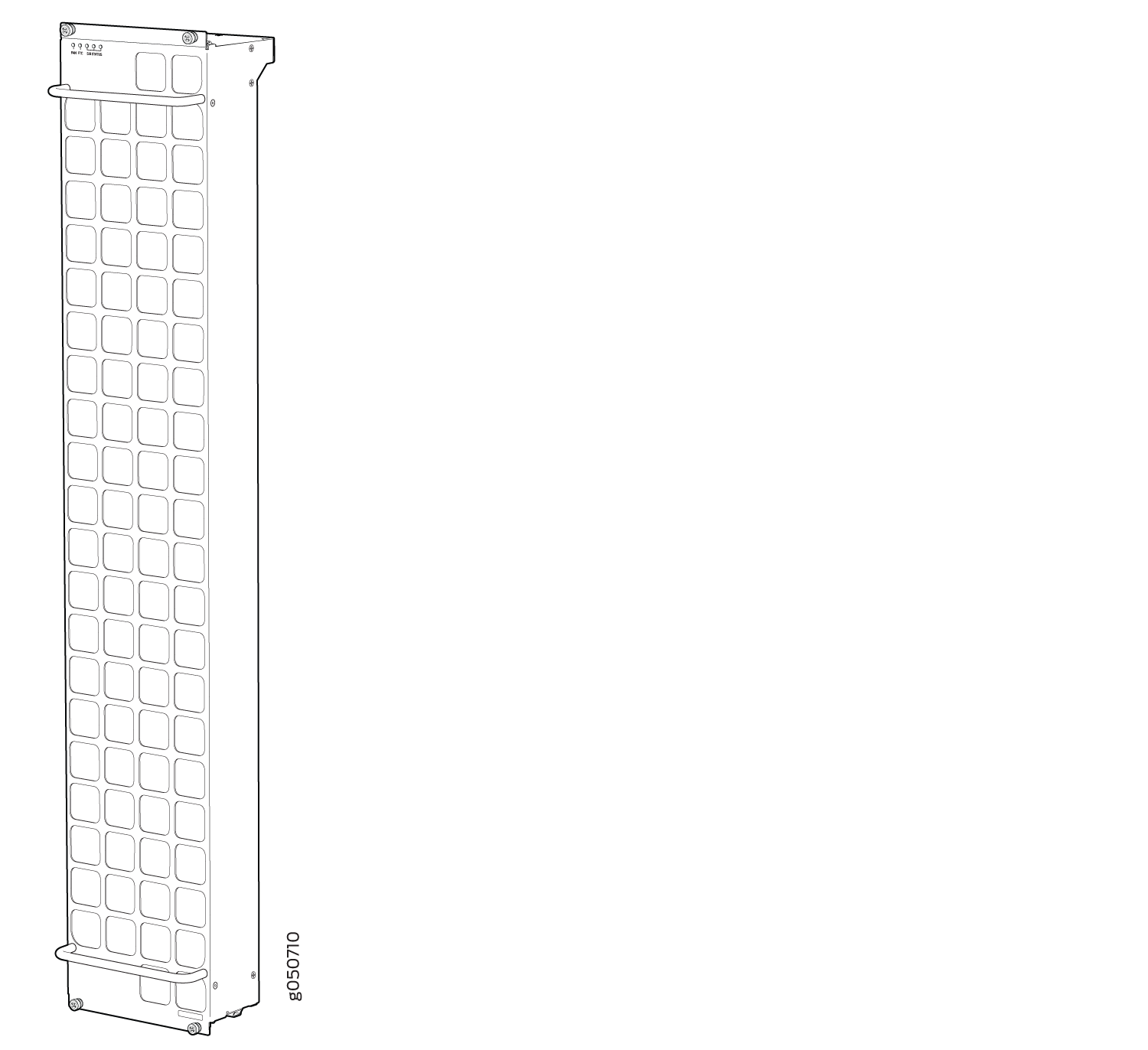
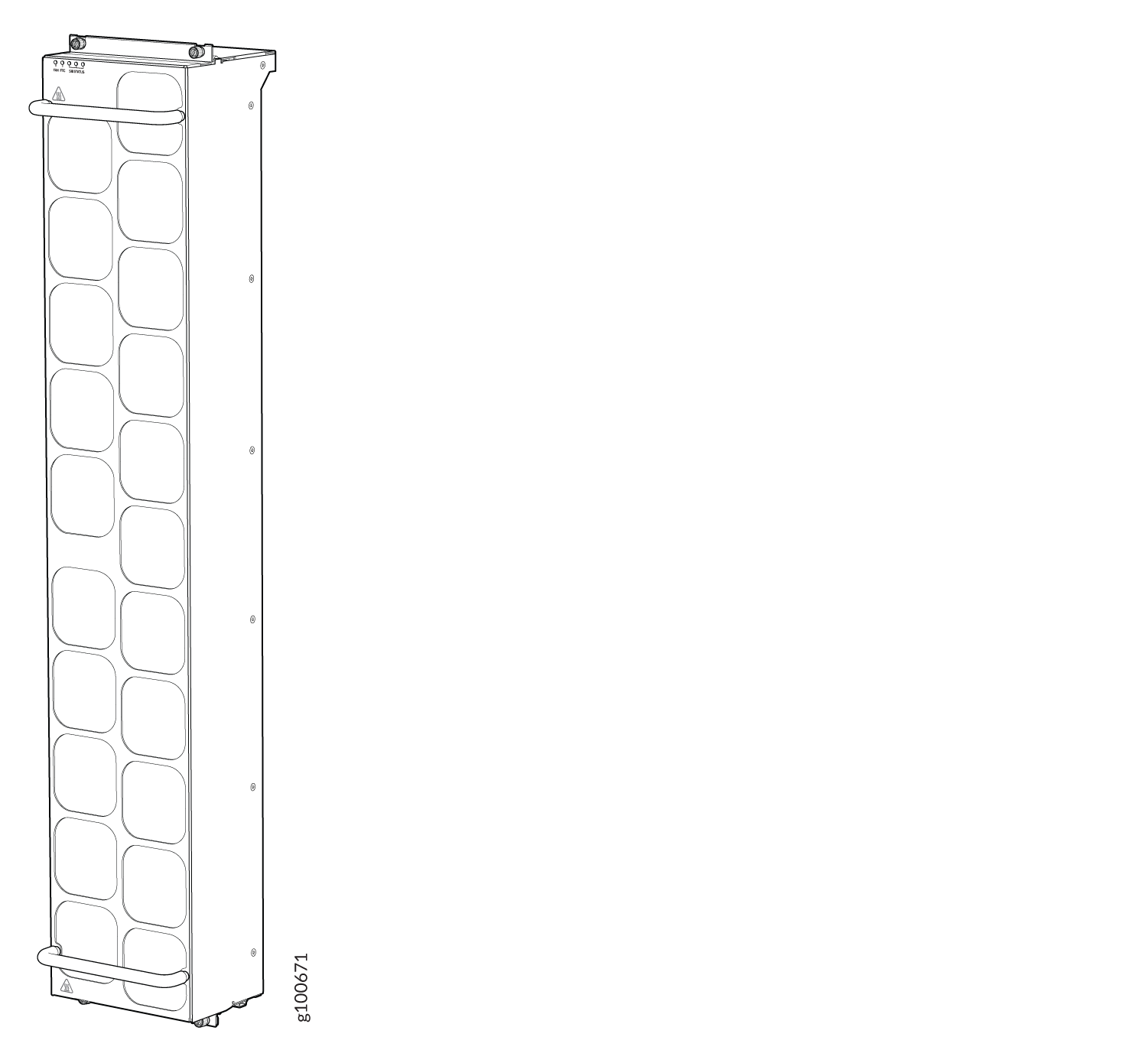

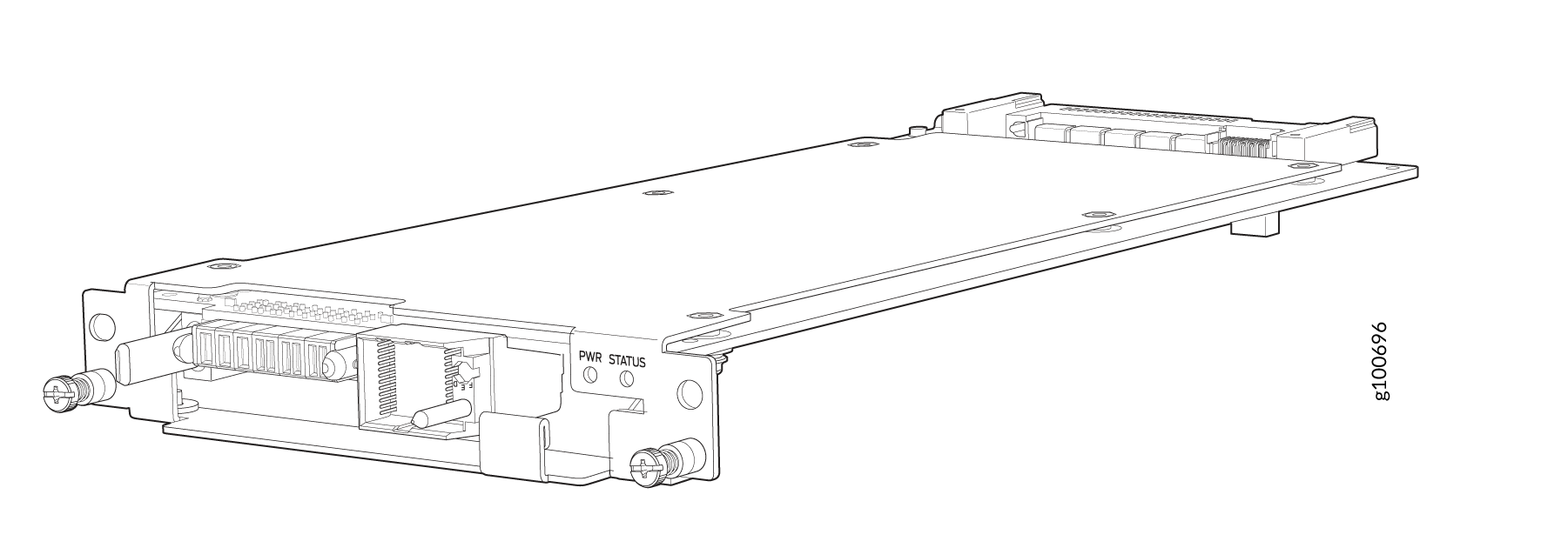
Power Supplies
The PTX10016 routers support AC, DC, high-voltage alternating current (HVAC), and high-voltage direct current (HVDC) by offering the following power supplies:
-
JNP10K-PWR-AC
-
JNP10K-PWR-AC2
-
JNP10K-PWR-AC3
-
JNP10K–PWR-DC
-
JNP10K-PWR-DC2
-
JNP10K-PWR-DC3
-
JNP10K-PWR-AC3H
Power supplies for the PTX10016 router are fully redundant, load-sharing, and hot-removable and hot-insertable FRUs. Each PTX10016 base configuration has five power supplies; redundant configurations hold the maximum of ten AC, HVAC, DC, or HVDC power supplies. Each power supply has an internal fan for cooling. You can install the power supplies in any slot. See Table 2 and Figure 11 through Figure 15.
Table 2 provides an overview of the differences among the power supplies.
|
Power Supply Model |
Input Type |
Wattage |
Minimum Junos OS Release |
|---|---|---|---|
|
JNP10K-PWR AC |
AC only |
2700 W |
17.4R1 |
|
JNP10K-PWR-AC2 |
AC, HVAC, or HVDC |
5000 W, single feed; 5500 W, dual feed |
18.2R1 |
|
JNP10K-PWR-AC3 |
AC |
|
24.3R1 |
|
JNP10K-PWR DC |
DC only |
2500 W |
17.4R1 |
|
JNP10K-PWR-DC2 |
DC only |
2750 W, single feed; 5500 W, dual feed |
18.2R1 |
|
JNP10K-PWR-DC3 |
DC only |
|
24.4R1-EVO |
|
JNP10K-PWR-AC3H |
HVAC or HVDC |
|
24.4R1-EVO |
Do not mix power supply models in the same chassis in a running environment. DC and HVDC power supplies can coexist in the same chassis when you do a hot swap of DC for an HVDC model. The system provides 2n source redundancy and n+1 power supply redundancy. If one power source fails, the power supply switches to the alternate source.
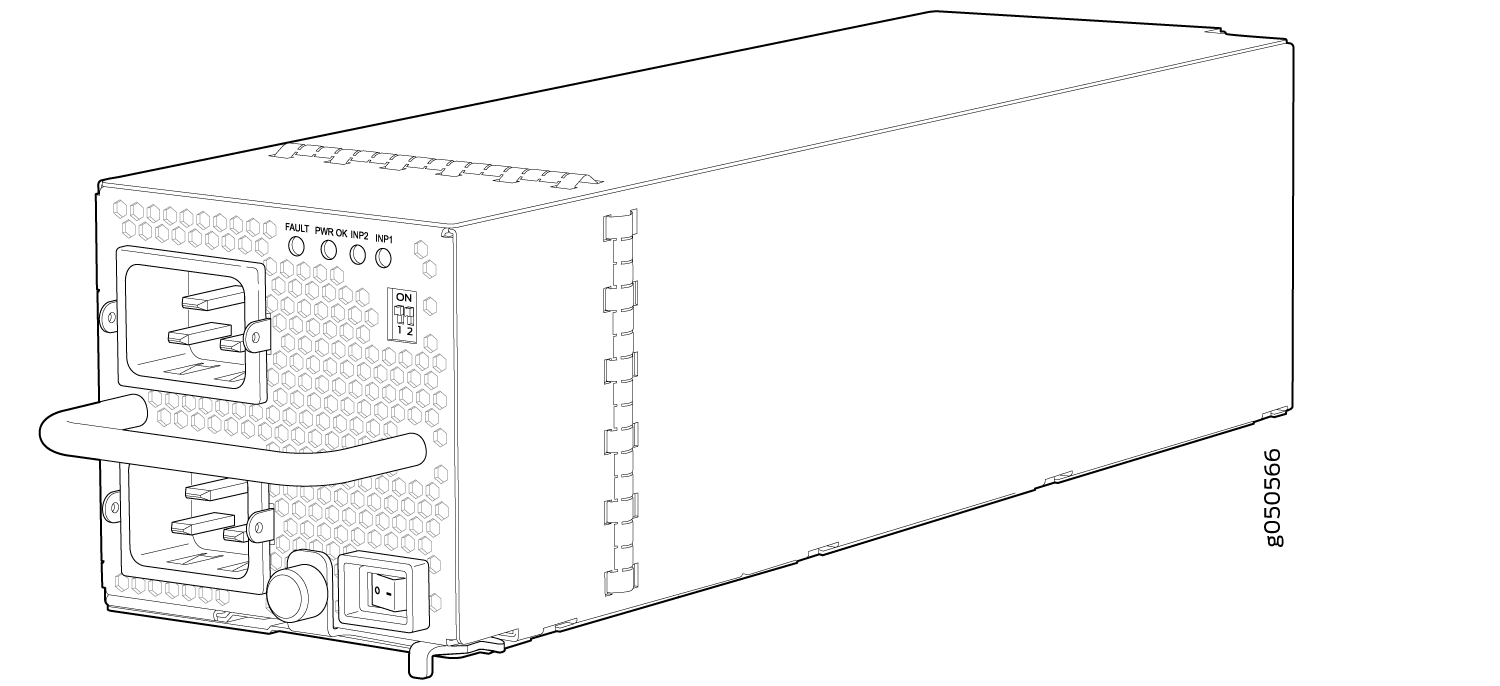
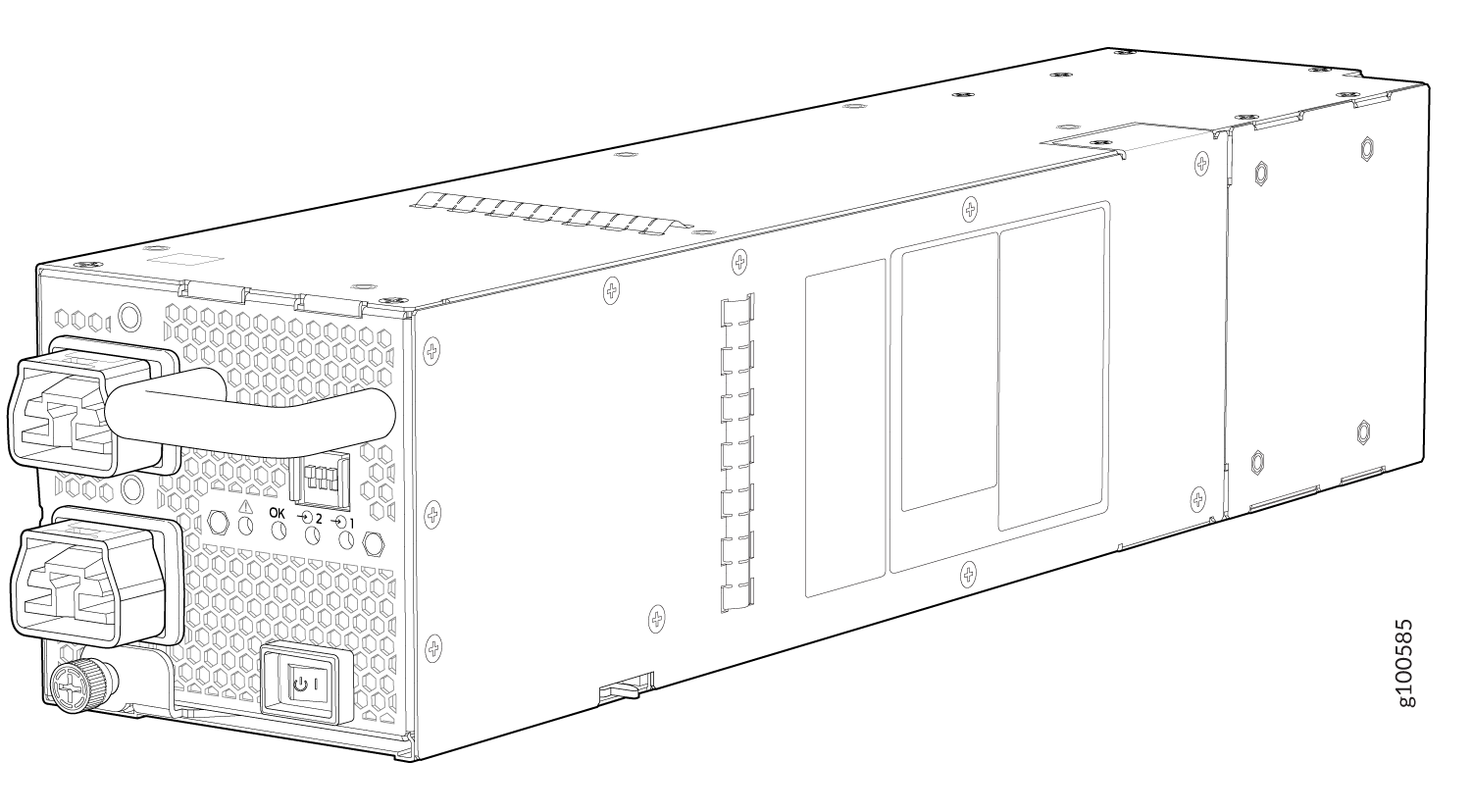
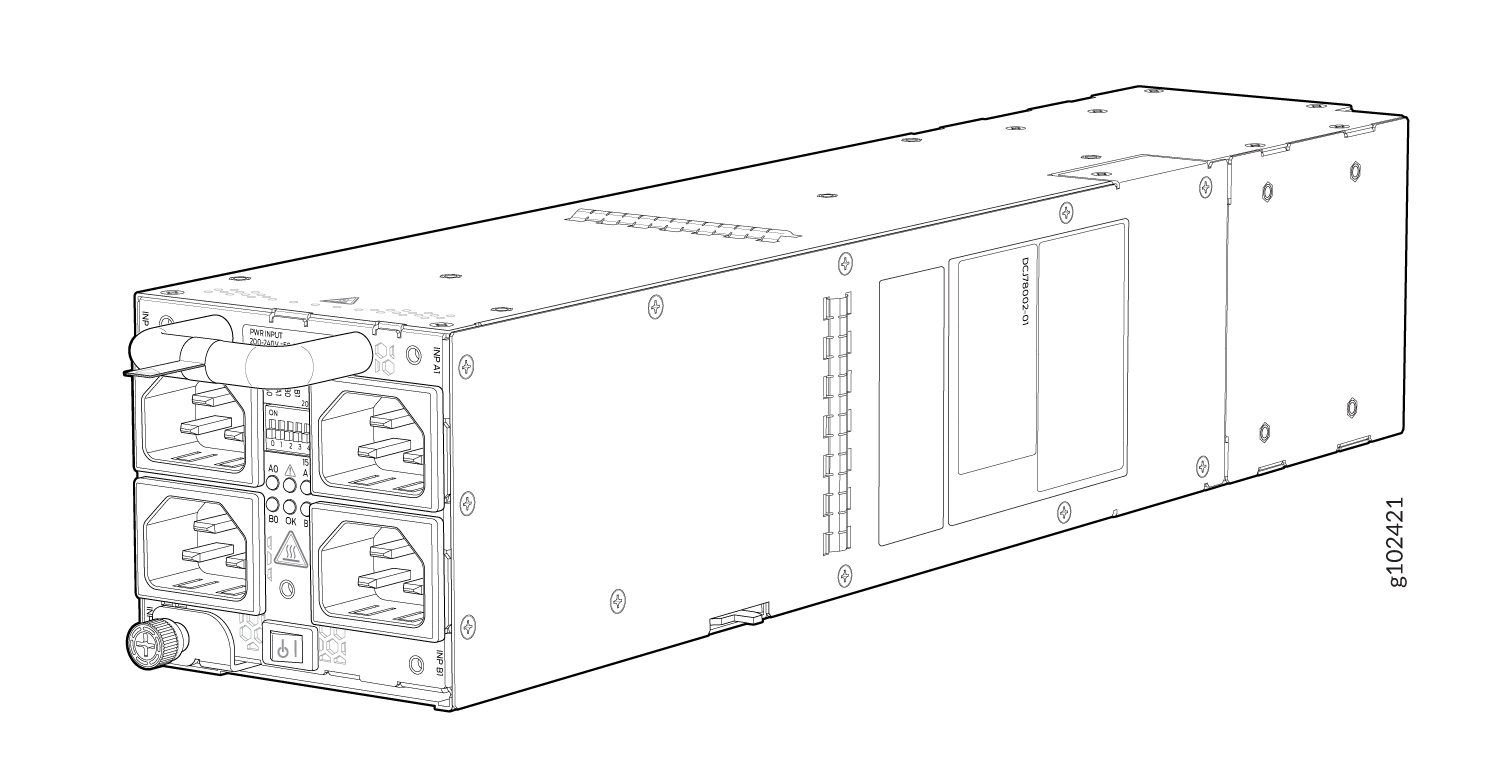
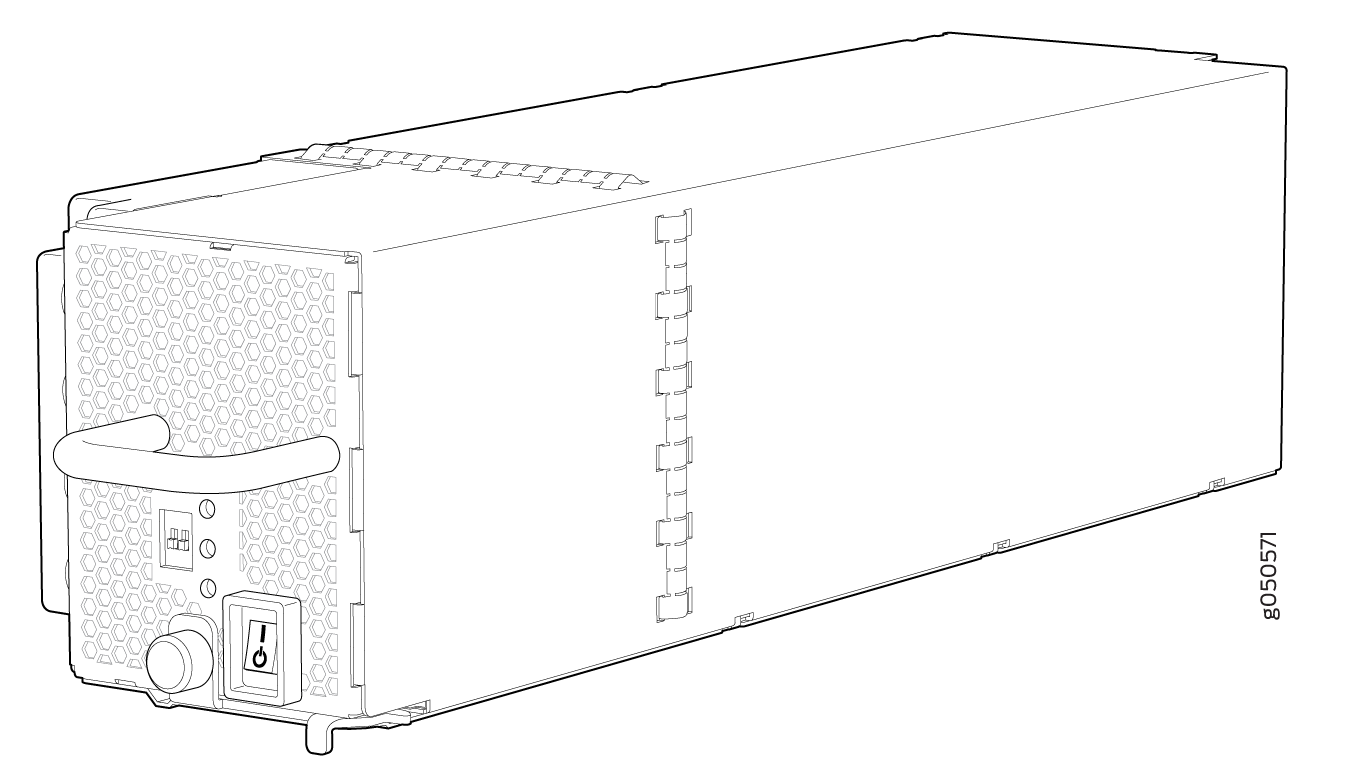
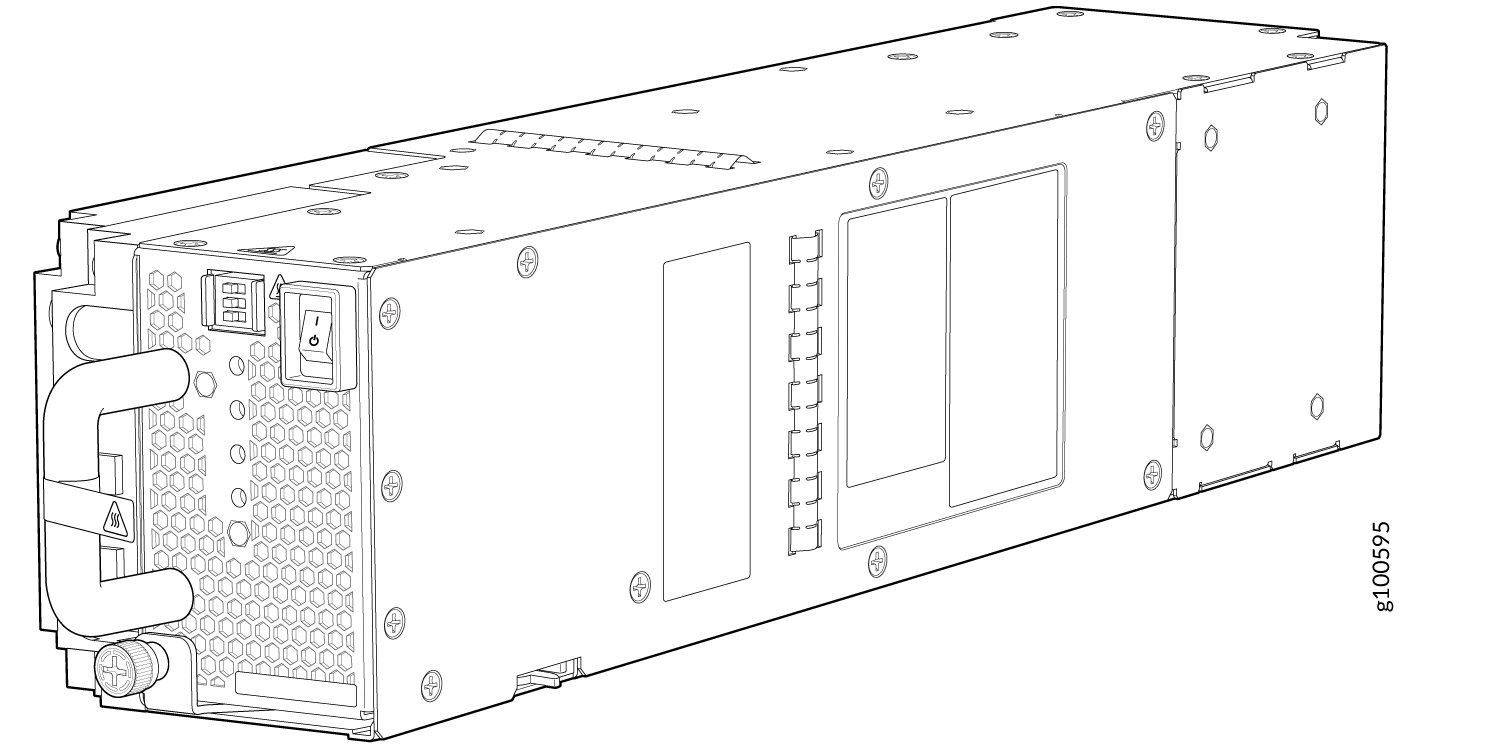
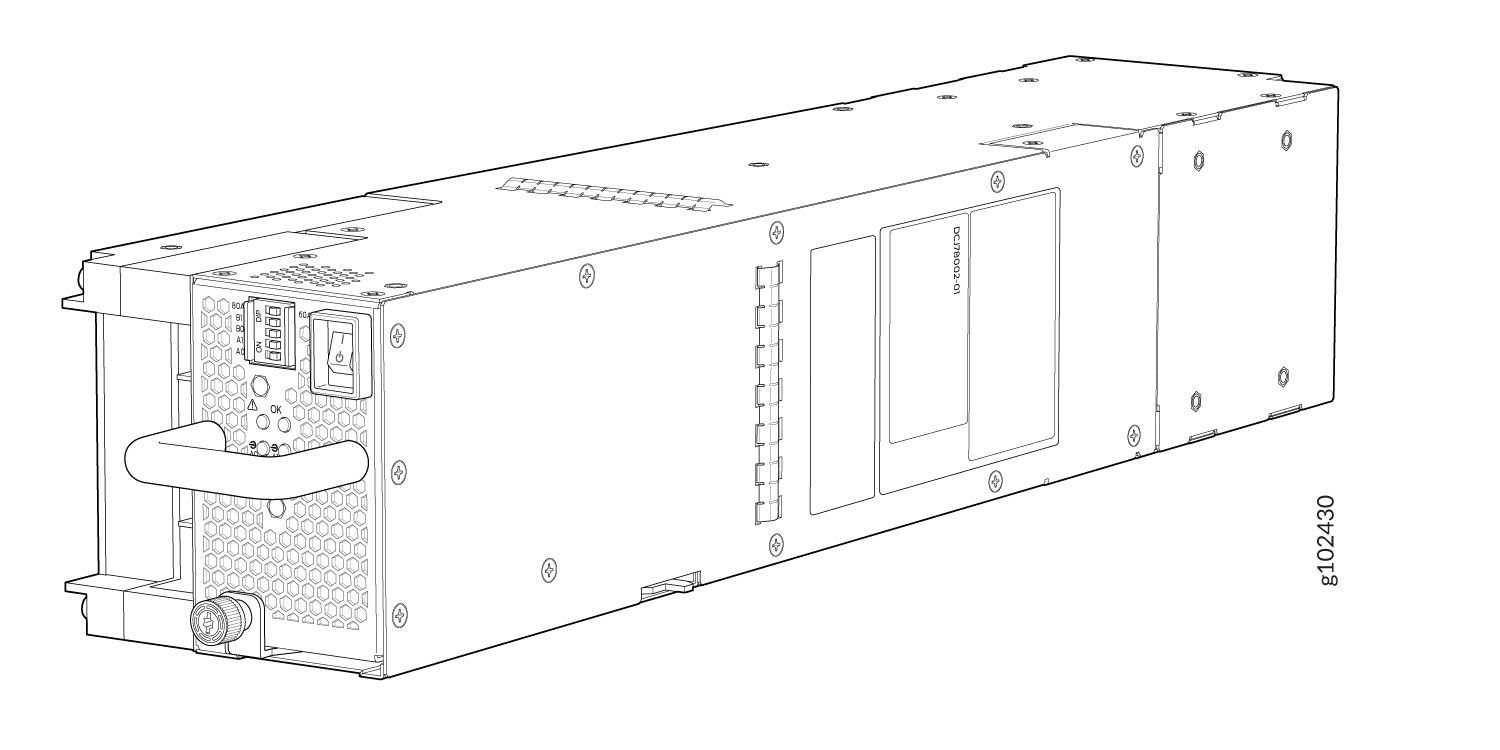
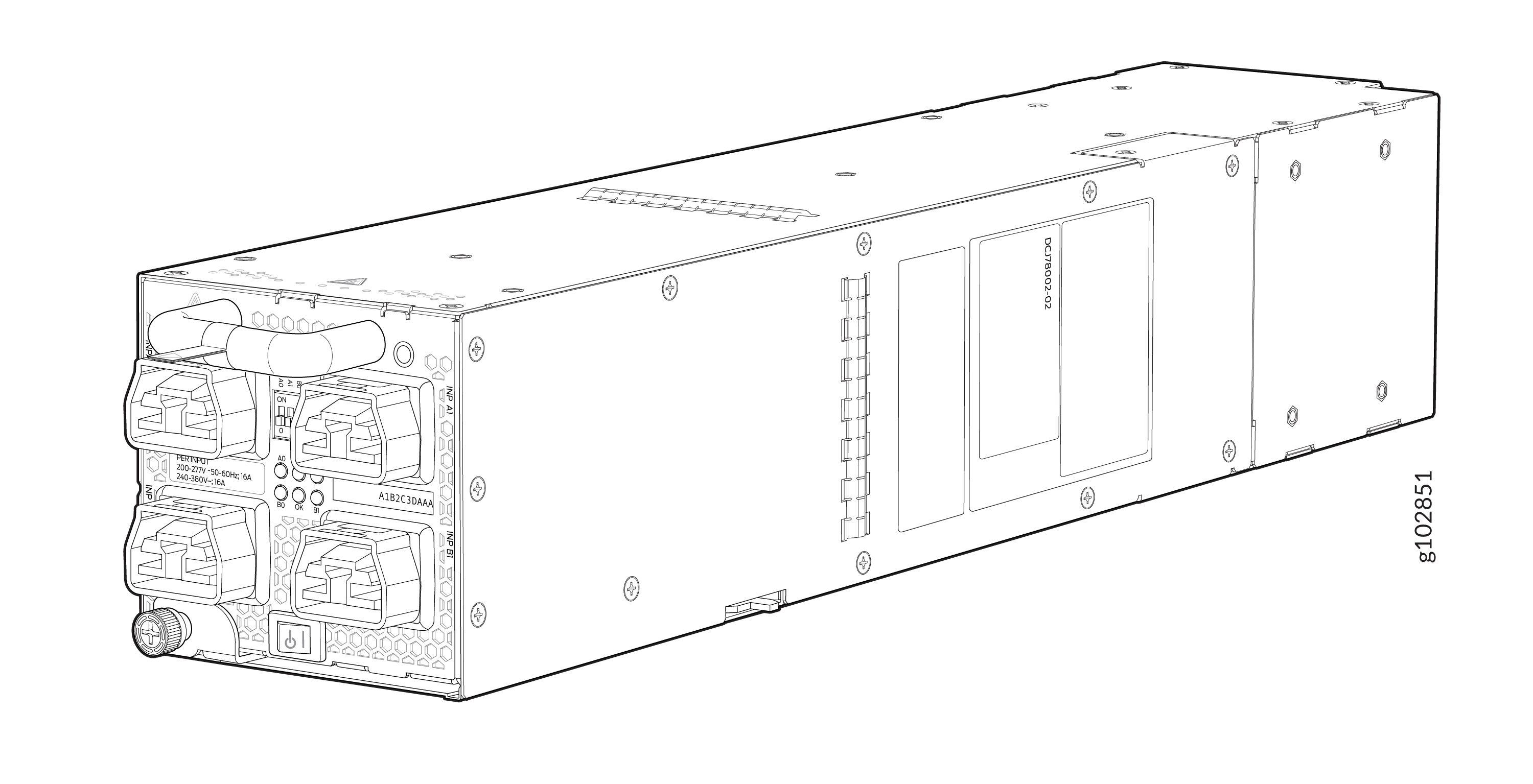
Software
The PTX10016 runs on Junos OS, which provides Layer 3 routing services. The same Junos OS code base that runs on the PTX10016 routers also runs on all Juniper Networks® EX Series Ethernet Switches, Juniper Networks® MX Series 5G Universal Routing Platforms, and Juniper Networks®SRX Series Firewalls. PTX10016 routers with the JNP10016-SF3 SIB installed in them come preinstalled with Junos OS Evolved Release 21.2R2 and later.
PTX10016 Components and Configurations
Table 3 lists the hardware configurations for the PTX10016 router and the components included in each configuration.
|
Router Configuration |
Configuration Components |
|---|---|
|
PTX10016-BASE Base AC configuration that supports the JNP10016-SF SIB and Junos OS |
|
|
PTX10016-BASE Base DC configuration that supports the JNP10016-SF SIB and Junos OS |
|
|
PTX10016-PREMIUM Redundant AC configuration that supports the JNP10016-SF SIB and Junos OS |
|
|
PTX10016-PREMIUM Redundant DC configuration that supports the JNP10016-SF SIB and Junos OS |
|
|
PTX10016-BASE3 Base AC configuration that supports the JNP10016-SF3 SIB and Junos OS Evolved Release 21.2R2 and later |
|
|
PTX10016-BASE3 Base DC configuration that supports the JNP10016-SF3 SIB and Junos OS Evolved Release 21.2R2 and later |
|
|
PTX10016-PREM2 Redundant AC configuration that supports the JNP10016-SF3 SIB and Junos OS Evolved Release 21.2R2 and later |
|
|
PTX10016-PREM3 Redundant AC configuration that supports the JNP10016-SF3 SIB and Junos OS Evolved Release 21.2R2 and later |
|
|
PTX10016-PREM2 Redundant DC configuration that supports the JNP10016-SF3 SIB and Junos OS Evolved Release 21.2R2 and later |
|
|
PTX10016-PREM3 Redundant DC configuration that supports the JNP10016-SF3 SIB and Junos OS Evolved Release 21.2R2 and later |
|
You can install up to 16 line cards in the PTX10016. Do not mix line cards supported by JNP10016-SF and JNP10016-SF3 SIBs in the same chassis.
Line cards and the cable management system are not part of the base or redundant configurations. You must order them separately.
If you want to purchase additional power supplies, SIBs, or RCBs for your router configuration, you must order them separately.
PTX10016 Component Redundancy
The PTX10016 router is designed so that no single point of failure can cause the entire system to fail. The following major hardware components in the redundant configuration provide redundancy:
Routing and Control Board (RCB)—The RCB consolidates the Routing Engine function with control plane function in a single unit. The PTX10016 routers can have one or two RCBs. When you install two RCBs, one functions as the primary and the other functions as the backup. If the primary RCB (or either of its components) fails, the backup can take over as the primary. See PTX10016 Routing and Control Board Description.
Switch Interface Boards (SIBs)—The PTX10016 routers have six SIB slots. In configurations that support JNP10016-SF SIBs, five SIBs are required for base operation, and the sixth SIB provides n+1 redundancy. All six SIBs are active and can sustain full throughput rate. With JNP10016-SF3, there is no redundancy for switch fabric. Each of the six switch fabric boards provides one-sixth of the full switching fabric bandwidth. The fabric plane can tolerate one SIB failure without any loss of performance. See the PTX10016 Switch Interface Board Description. You must not mix the two types of SIBs in the same chassis.
-
Power supplies—The PTX10016 routers require three power supplies for minimum operation (two RCBs, two fan trays, six SIBs, and no line cards). Additional power supplies provide n+1 redundancy for the system. AC, DC, HVAC, and HVDC systems tolerate a single power supply to fail without system interruption. If one power supply fails in a fully redundant system, the other power supplies can provide full power to the PTX10016 indefinitely.
The PTX10016 routers also support power source redundancy. Two sets of lugs are provided for the JNP10K-PWR-DC cables, four sets of lugs are provided for the JNP10K-PWR-DC2 cables, and two AC power cords are provided for each JNP10K-PWR-AC and JNP10K-PWR-AC2 power supply.
Cooling system—The fan trays have redundant fans, which are controlled by the fan tray controller. If one of the fans fails, the host subsystem increases the speed of the remaining fans to provide sufficient cooling for the router indefinitely. See PTX10016 Cooling System and Airflow.
PTX10016 Hardware and CLI Terminology Mapping
This topic describes the hardware terms used in PTX10016 router documentation and the corresponding terms used in the Junos OS CLI. See Table 4.
Hardware Item (CLI) |
Description (CLI) |
Value (CLI) |
Item in Documentation |
Additional Information |
|---|---|---|---|---|
Chassis |
PTX10016 |
– |
Router chassis |
|
Fan tray |
JNP10016-FAN or JNP10016-FAN2 |
n is a value in the range of 0–20 for the JNP10016-FAN or a value in the range of 0–41 for the JNP10016-FAN2. The value corresponds to the individual fan number in the fan tray. |
Fan tray |
|
FPC (n) |
Abbreviated name of the Flexible PIC Concentrator (FPC) On the PTX10016, an FPC is equivalent to a line card. |
n is a value in the range of 0–15 for the PTX10016. The value corresponds to the line card slot number in which the line card is installed. |
Line card (The router does not have actual FPCs—the line cards are the FPC equivalents on the router.) |
|
PIC (n) |
– |
Value of n is always 0. |
– |
|
PSM (n) |
Abbreviation for power supply module One of the following:
|
n is a value in the range of 0–9. The value corresponds to the power-supply slot number. |
AC, DC, HVAC, or HVDC power supply |
One of the following: |
RE |
RE (n) |
n is a value in the range of 0–1. Multiple line items appear in the CLI if more than one RCB is installed in the chassis. |
RCB |
|
SIB (n) |
This field indicates:
|
n is a value in the range of 0–5. |
Fabric plane |
show chassis fabric sibs |
Xcvr (n) |
Abbreviated name of the transceiver |
n is a value equivalent to the number of the port in which the transceiver is installed. |
Optical transceivers |
